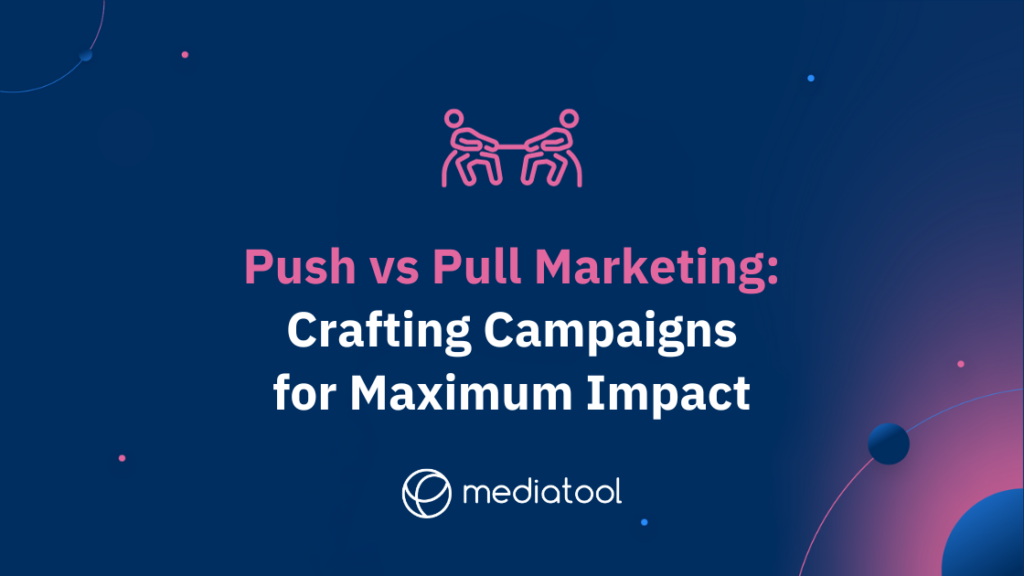You’ve likely been bombarded by an array of marketing messages before your morning coffee even cools down.
You may have been served an unskippable ad on your favorite video platform, or perhaps you found yourself pulled into an article after a casual Google search.
These are instances of ‘push vs pull marketing’ at play.
Here’s the conundrum: While every business aims to reach its audience, not every method resonates the same way for everyone.
In this cluttered marketplace, how can brands effectively capture the attention of their target audience without overwhelming or alienating them?
The wrong strategy can mean missed opportunities, wasted resources, or even alienating potential customers. The stakes are high, and the nuances matter.
That’s why understanding the dynamics of both push and pull marketing is essential.
We’ll unravel these strategies in this article, highlighting their strengths, applications, and ways to strike a perfect harmony between them.

What is Push Marketing?
It’s bold, it’s proactive, and it’s all about taking that initiative.
Push marketing epitomizes the essence of outbound marketing, where businesses actively put their products and services in front of their target audience.
Push marketing is about making a strong, immediate impact. It uses tactics such as direct mail, TV commercials, and online paid ads to grab attention in high traffic areas.
The focus of push marketing is on immediate customer engagement, often through push notifications and other direct marketing tactics that place products front and center for the target audience. It’s a marketing push strategy that doesn’t shy away from being seen; whether it’s a billboard in a bustling street or a flashy ad on social media platforms, the goal is to be noticeable.
This approach can be particularly effective for short-term sales and introducing new products to the market. With push marketing, the marketing team controls the message, ensuring that key features and benefits are highlighted to draw consumers. However, it’s a balancing act. Too much pushing can be overwhelming, while the right amount can lead to quicker sales and increased website traffic.
Push marketing tactics, as part of broader marketing efforts, often complement pull marketing strategies. While push marketing focuses on proactive outreach, pull marketing is more about creating content and experiences that pull customers in. Together, these two strategies form a comprehensive promotional strategy, catering to different stages of customer engagement and decision-making.
What is Pull Marketing?
Unlike its outbound counterpart, pull marketing strategies focus on drawing potential customers in rather than reaching out.
Imagine the allure of a captivating blog post or the intrigue of an SEO-optimized web page — that’s pull marketing in its essence.
Pull marketing focuses on creating a magnetic presence, one that attracts the target audience through value-driven content, compelling social media marketing, and organic search engine optimization. It’s the art of being present where the customer is actively seeking information or solutions.
This inbound marketing approach builds brand loyalty by nurturing a relationship with the existing customers and the potential ones. It’s not just about the immediate sale but about fostering long-term business growth. Pull marketing tactics like engaging how-to videos, informative web pages, and immersive social media platforms create an environment that encourages informed buying decisions and deeper customer engagement.
Additionally, pull marketing thrives on word-of-mouth marketing, allowing satisfied customers to naturally draw new customers. It’s a strategy that starts with trust and grows through genuine connections. This approach, while seemingly laid-back, requires meticulous planning and a keen understanding of marketing tactics.
Pull marketing strategy is not just about attracting website traffic; it’s about creating a journey for the customer, ensuring each interaction adds value, and aligns with the overall marketing strategy. As one of the two broad categories of marketing, pull marketing complements push marketing strategies, balancing the act of reaching out and drawing in.
Key Differences Between Push and Pull Marketing
You’ve seen both push and pull marketing strut their stuff separately.
But what happens when we pit them against each other?
Direction of Approach:
Push: Like an enthusiastic dog chasing after a ball; push marketing goes towards the consumers. It’s all about getting the brand or product in front of them, whether they asked for it or not.
Pull: This is the cool cat approach, lounging and waiting for the consumers to come. It’s about being so irresistible and engaging that the consumers can’t help but be drawn in.
Nature of Engagement:
Push: It’s immediate and direct, often resembling a sprint. There’s a sense of urgency. “Check this out NOW!”
Pull: Marathon vibes here. It’s about building a steady pace and fostering deeper connections and relationships over time.
Medium & Tactics:
Push: Think billboards, radio spots, direct mail, or those pop-up ads that sometimes (read: often) test our patience. It’s about visibility and making sure the consumer sees the message.
Pull: Blogs, SEO, social media content, and tutorials reign supreme. It’s about creating value-packed content that consumers actively seek out.
Consumer Relationship:
Push: It’s a bit like speed dating. The brand takes the initiative, and the consumer decides quickly whether they’re interested.
Pull: More of a slow-burning romance. The brand nurtures and builds relationships, strengthening loyalty and deeper consumer connections.
Feedback Loop:
Push: Typically, the feedback here is more quantitative. How many flyers were taken? How many people clicked on the ad?
Pull: Because it’s centered around engagement, feedback is often qualitative. Comments on a blog post, shares of a tutorial video, and discussions on a forum give rich insights into consumer sentiments.
Control vs. Collaboration:
Push: The brand’s in control here. They craft the message, decide on the timing, and determine the medium.
Pull: It’s more collaborative. While the brand sets the stage, consumers have a say in the dialogue. The brand listens, adapts, and evolves based on consumer input.
Now, you might wonder, is one inherently better than the other? Not really. It’s like asking if a hammer is better than a screwdriver. They have different purposes! Depending on your goals, target audience, and the nature of your product or service, one might suit you better at a given time. But true marketing mastery? That’s in knowing how to wield both with finesse.
So, feeling like a push-and-pull marketing connoisseur yet?
We’re about to get into it, so don’t go anywhere!
Push vs. Pull Marketing Strategies
Let’s get into the real meat of the matter: crafting strategies around these two power-packed approaches. Like a master chef knowing when to sear and when to simmer, a marketer must know when to push and when to pull. Let’s cook up some strategy!
Identifying Objectives:

Push: Best when you’re launching a new product, promoting limited-time offers, or looking to quickly boost sales and awareness. It’s the “Hey, look at me now!” approach.
Pull: This is for the long haul. If you aim to establish brand loyalty, become an industry thought leader, or organically grow your customer base, pull’s your go-to.
Understanding Your Audience:
Push: If your audience isn’t aware they need your product, you’ll need to tell ’em! It’s great for innovative products or when targeting a less digitally-savvy audience.
Pull: Perfect for a well-informed audience. They research, compare, and love brands that provide value, not just products.
Budget Considerations:
Push: Typically, this can be more expensive upfront. Consider costs for print ads, TV commercials, or direct mail campaigns.
Pull: It might seem cost-effective initially with content creation, but remember, it’s a marathon! SEO optimization, maintaining high-quality content, and community engagement require consistent investment.
Measurement & Metrics:
Push: Metrics are more direct – click-through rates, direct sales from an ad, number of flyers distributed vs. responses received.
Pull: Dive deeper with metrics like engagement rate, time spent on site, content shares, organic search traffic, and customer lifetime value.
Flexibility & Adaptability:
Push: Changes aren’t easy or cheap once a billboard is up or a commercial is aired. The strategy here needs to be spot-on from the get-go.
Pull: The digital realm offers more agility. Didn’t get the engagement you wanted on that blog post? Tweak and republish. Need to update info? Just edit.
Building Relationships:
Push: It’s like speed dating. You get a brief window to impress. It’s more transactional, focusing on the immediate sale.
Pull: This is the dinner and a movie type. It’s about creating lasting connections, providing consistent value, and nurturing a community around your brand.
Sustainability & Long-Term Growth:
Push: The impact can be immediate but might wane over time. It’s brilliant for bursts of attention.
Pull: Think of it as planting a tree. It takes time to grow, but once it does, it provides shade, fruits, and a solid presence for years.
Remember that the great Push vs. Pull debate is not about picking sides. It’s about harmonizing them for your symphony of success. Sometimes you’ll lead with a strong push; other times, you’ll sway to the pull rhythm. The key? Know your goals and audience, and dance fluidly between the two.
Ready to strategize like a pro? Let’s keep this momentum going!
Examples of Push Marketing
Alright, time for a little show-and-tell. Let’s put our push marketing glasses on and explore real-world examples that have made us go, “Oh, that’s push marketing in action!” Shall we?
Direct Mail Campaigns:
What’s the deal?: You know those postcards, flyers, or brochures you get in the mail announcing a sale or introducing a new store in your neighborhood? That’s push marketing, my friend!
Why it works: Physical mail can create a tangible connection. Plus, there’s the excitement of receiving something personal(ish) in our mostly digital world.
Telemarketing:
Ring, Ring!: Remember the last time your dinner was interrupted by a call pitching a new insurance policy or a credit card offer?
The push factor: It’s direct, personal, and offers an immediate chance to answer questions and handle objections.
Trade Shows & Product Demonstrations:
Spotlight’s on: Brands often showcase their products at events, conventions, or in-store displays.
Pushy enough?: Absolutely! They directly engage with potential customers, demonstrate the product’s value, and often drive immediate sales.
TV & Radio Commercials:
The classics: These are the age-old staples of push marketing. A catchy jingle or a memorable ad can embed a brand in the consumer’s mind.
Why we love (or love to mute) them: They capture attention, sometimes entertain, and frequently embed product knowledge even if we’re passive viewers or listeners.
Point of Sale Displays and Promotions:
Spotlight in the store: Those enticing candy displays by the checkout counter? The exclusive “buy one, get one free” offer banners? Push marketing at its finest.
Temptation galore: These strategically placed promotions catch consumers right when they’re ready to purchase.
Online Banner Ads & Pop-ups:

Digital era push: Have you ever read a blog, and BAM, a big flashy shoe ad pops up? That’s digital push marketing knocking on your screen.
Capturing the click: While often maligned for being intrusive, when tailored correctly, they can be super effective, especially with retargeting strategies.
Email Blasts:
Inbox surprise: Not the personalized “We miss you” emails, but the “HUGE SALE! EVERYTHING MUST GO!” kind.
The verdict: If done too often, they can lead to the dreaded unsubscribe. But a well-timed, well-crafted blast can lead to a significant sales boost. On average, email marketing boasts an impressive ROI, driving $36 for every dollar spent, outperforming other channels and showcasing the potential effectiveness of push marketing through email campaigns.
Alright, did we demystify some of that push marketing fog? By recognizing these tactics in the wild, we become better consumers and sharper marketers. Up next is the world of pull. But first, a quiz: Can you spot any push marketing in action around you right now?
Examples of Pull Marketing
Okay, so you’ve seen the push. Now let’s embrace the pull. Time to explore the subtle art of pull marketing with real-life examples that have undoubtedly made you nod along, thinking, “That has definitely pulled me in!” Let’s dive deep!
Blogs & Articles:
Been there, read that: Ever Googled “how to fix a leaky faucet” and landed on a hardware store’s step-by-step guide? That’s a pull in action.
Why it’s magnetic: These informative pieces provide value, build trust, and position the brand as an expert. They pull you in with content and keep you with quality.
Search Engine Optimization (SEO):
The silent charmer: When you search for “best hiking boots” and click on the first non-ad link, SEO is working its magic.
Pulling rank: Through keywords, quality content, and website optimization, brands ensure they’re the first thing you see when searching for relevant topics. In fact, 68% of online experiences begin with a search engine, highlighting the paramount importance of mastering SEO for visibility and engagement.
Social Media Engagement:
Scroll, Like, Repeat: Those aesthetically pleasing Instagram feeds of brands peppered with helpful tips, Q&A sessions, and user-generated content? Classic pull!
Community vibes: It’s not about blatant product promotions. It’s about creating a community and a narrative that people want to follow and engage with.
Webinars & Tutorials:
Teach to reach: Brands offering free online classes or YouTube tutorials on subjects related to their products.
Knowledge = Power: By educating audiences and showcasing expertise, they create a bond beyond transactions. In fact, more than half of marketers (53%) recognize webinars as the top-of-the-funnel format that generates the most high-quality leads, cementing their value in a comprehensive marketing strategy.
Referral Programs:
Friends bringing friends: Remember when a buddy shared a code for a cool app, saying you both get perks if you sign up? That’s pull!
Why we’re hooked: It’s based on trust. We will likely try something new if a trusted friend vouches for it. In fact, recommendations from friends and family are 38% more likely to influence brand discovery for Millennials, highlighting the significant impact of personal connections in their purchasing decisions.
Influencer Collaborations:
Star-studded attraction: Not the overt “Buy this now!” ads, but the subtle “Here’s how I incorporate this into my routine” posts by influencers.
Authentic allure: Authentic influencer endorsements feel genuine, making us more inclined to explore the brand further. This method of marketing is so prevalent that over 80% of marketers have dedicated a portion of their budget specifically for influencer collaborations, underscoring the value they see in this pull marketing strategy.
Engaging Email Newsletters:
Not the usual inbox clutter: Newsletters that offer insights, stories, or exclusive content tailored to subscriber interests.
Beyond the sales pitch: They provide consistent value, ensuring subscribers eagerly await the next edition instead of sending it to the dreaded spam folder.
Conclusion
In the intricate tapestry of today’s marketing landscape, understanding the balance between push and pull marketing becomes paramount. While push marketing focuses on immediate engagement and visibility, it’s evident that pull marketing emphasizes the long game, aiming to foster deep-rooted relationships and brand loyalty. The nuances in their application highlight the diversity of marketing strategies available to brands.
A push marketing strategy might involve tactics like direct mail campaigns, TV commercials, or even the somewhat contested online banner ads. It’s proactive, capturing the essence of outbound marketing, seeking to place a brand or product directly in the consumer’s view. This approach can be likened to casting a wide net, hoping to capture as many potential customers as possible in the vast sea of consumers.
On the other hand, a pull marketing strategy thrives on attraction. Here, social media marketing, SEO-optimized blogs, and engaging content become the cornerstones. Pull marketing tactics offer value to the audience, allowing brands to stand out not because they’re shouting the loudest, but because they’re providing the most value. The heart of pull marketing lies in its patience and precision.
However, it’s essential to note that neither strategy operates in isolation. The magic often happens when they’re harmoniously integrated. Depending on a brand’s objectives, understanding when to employ a push or pull approach—or a blend of the two—can determine the success of its overall marketing strategy.
While push marketing focuses on proactive outreach, pull marketing zeroes in on attraction and organic growth. As marketers, recognizing the strengths and applications of both strategies enables us to create more effective, resonant, and impactful campaigns. As the world of marketing continues to evolve, staying attuned to these dynamics will be essential for future success. Whether through outbound marketing efforts or leveraging social media marketing for pull, mastering the dance between push and pull remains at the heart of marketing excellence.





